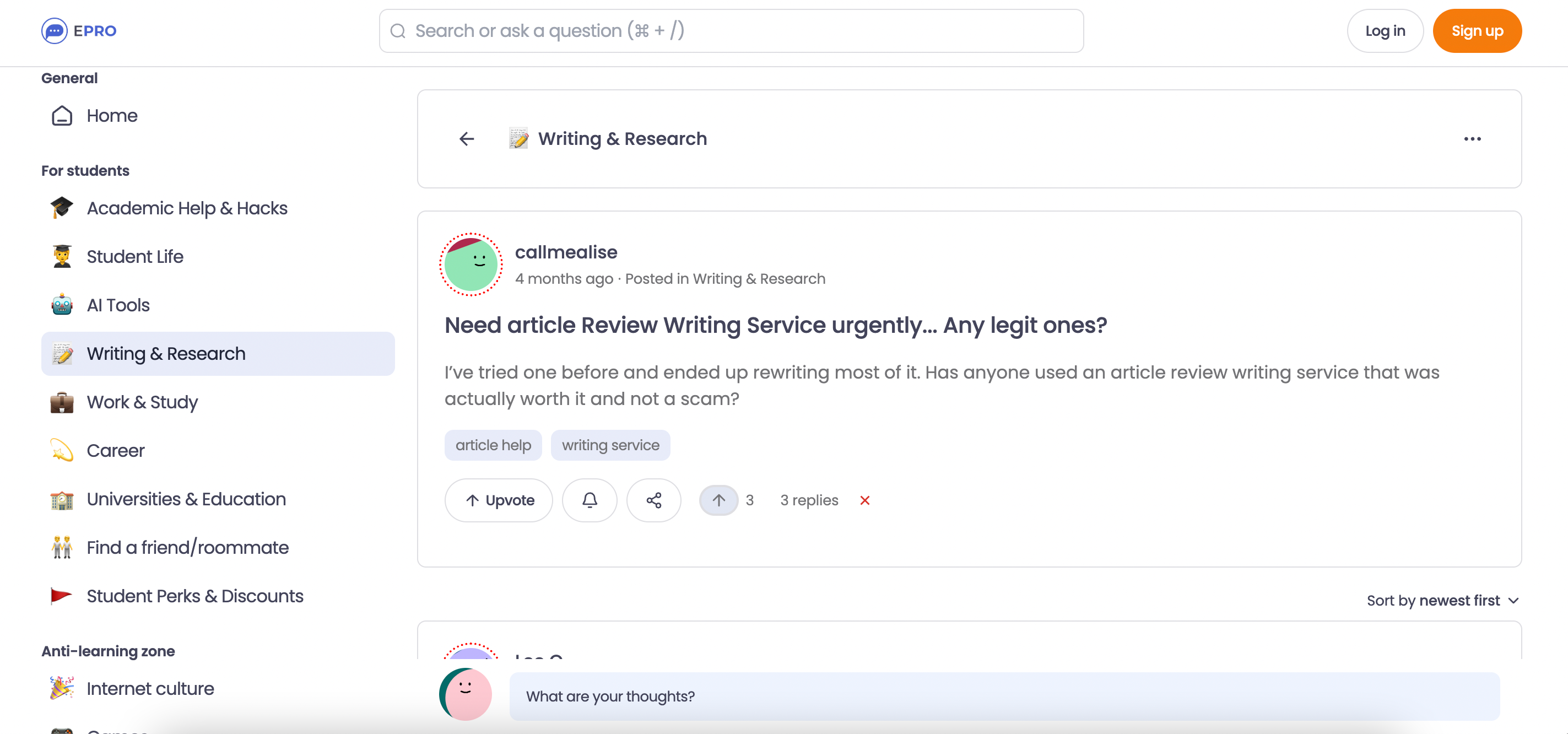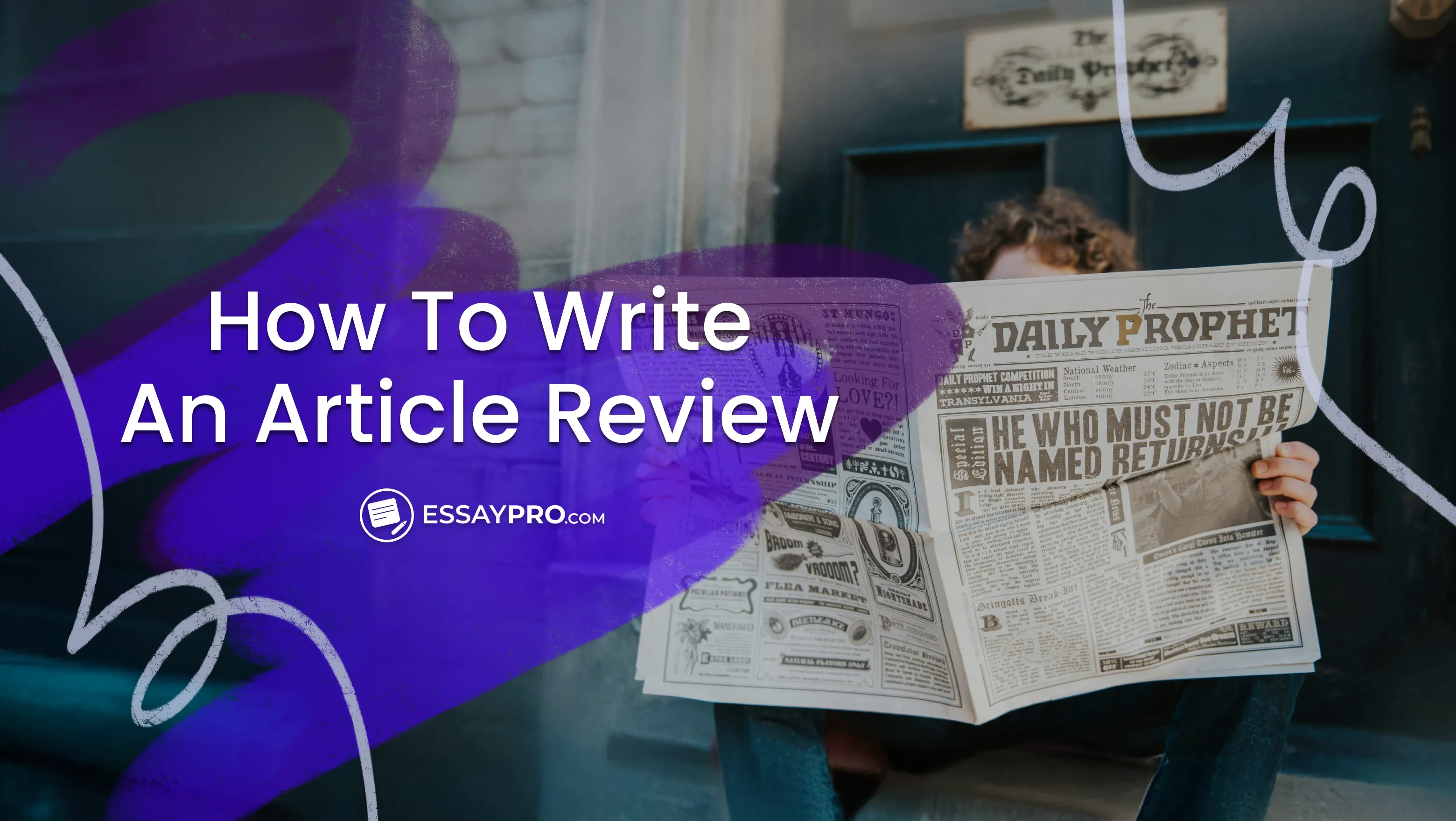You read the article three times and still have no clue what to say. Your notes are a mess, the deadline’s breathing down your neck, and your professor expects a ‘thoughtful critique.’
Most of the time, writing an article review feels like being asked to build a house with no blueprint. That’s what this guide is here for. You’ll learn how to read, analyze, and write a review that sounds like you understood the article.
And if you ever need backup, EssayPro’s got your back with essay writing services and academic help whenever you need it most.
🤔Article Review Got You Stuck?
Jump into our EssayPro Community, we’ve got more real student stories like this inside. Sometimes, hearing how others overcame struggles can be more powerful than another tip list.

What is an Article Review?
An article review is a written evaluation of a published paper, usually academic or research-based. You explain what the author argues, assess how well they support it, and share your take on the article’s value. A review looks at structure, methods, tone, and logic.
Main goals include the following:
- Understanding the author’s main idea and intent
- Evaluating the logic, evidence, and structure
- Placing the article in a broader academic context
A good review should:
- Flow with clarity and purpose
- Show sharp, independent thinking
- Balance fairness with critique
- Use precise references from the article
- Stick to the required academic format
Still wondering what is an article review? Then, let our expert article review writing service handle summarization, argument evaluations, formatting, and references for you!
Types of Review
Different reviews demand different strategies. Therefore, knowing the type you’re writing can shape the tone, structure, and depth. To write an article review effectively, you need clarity on purpose before anything else. Here is each kind discussed by our research paper writing service experts:
Journal Article Review
A journal article review takes a published academic piece and analyzes it for experts. You focus on the author’s claims, evidence, importance, citations, tone, and structure. A journal article should offer answers to these questions: What's the author claiming? How did they prove it? Who cares about it, and why?
Research Article Review
A research article review focuses on original studies and their data. You assess the study design (graphs, methods, outcomes, etc.), analyze patterns, and test hypotheses. Your job is to make sure none of it falls apart. How was the study designed? Who or what did they observe? Did they follow through? A good review shows that the findings mean something or that they miss the mark in a significant way.
Science Article Review
Science article reviews ask you to unpack experiments, test tubes, equations, and carefully labeled figures. You’re looking at the methods and asking if they check out. Did the data actually say what the author claims it said? Could someone else replicate it and get the same results? You take complex work and rephrase it for someone who didn’t spend three weeks reading about algae mutations or quantum dots.
Critical Review
With a critical review, you evaluate an article’s ideas while also presenting your own. You agree or disagree, and explore alternative interpretations. The goal is to prove you thought it through. You build a case, support your claims, and let the reader feel the gears turning in your head. A good critical review feels alive, sharp, curious, and almost impossible to ignore.
How to Cite Sources When Writing
Every citation signals that you’ve done the work. When writing a review of an article, correction is a proof of accuracy and integrity. Use the assigned format, one of the two: APA or MLA. APA focuses on the publication year and is perfect for the research that changes quickly; MLA, on the other hand, emphasizes the author and title replacement and is often used in humanities.
How to Write an Article Review in APA Format
APA format focuses on clarity and structure. Here's how to write an article review in APA format:
How to Write an Article Review in MLA Format
MLA keeps things cleaner, no title page or abstract. Here's a breakdown:
4 Things You Can Do to Prepare Before Writing
The right foundation turns confusion into clarity. This section outlines a practical guideline for writing an article review that doesn’t wander. If you’re working on a more complex project, our dissertation services can support you through deeper academic work.
Here’s what this process covers:
- Think through the structure
- Preview and annotate the article
- Rewrite the article in your own words
- Analyze with specific questions
1. Create Structure Before Writing
Your structure decides how clear your ideas feel to the reader. Start loose, then build tight. Sketch it before you write it.
Here’s how to shape your outline:
- Title and citation at the top
- Short introduction with the article’s title and purpose
- A section for summarizing main ideas
- A detailed space for analysis and evaluation
- A final paragraph that closes the review
- A reference list following the assigned format
2. Read With Questions
Reading isn’t the goal; understanding is. As you read, ask specific questions that reveal the article’s spine.
Use these questions as your anchor:
- What is the author’s main argument?
- What evidence or sources back it up?
- How is the argument organized or developed?
- Does the article rely on data, theory, or both?
- What kind of tone or perspective does the writer bring?
3. Rewrite the Article in Your Own Words
You need to know what you’re talking about before you critique it. This draft is for your eyes only. It’s the version that gets cleaned later.
Use this checklist:
- Write a short summary using your own sentence structure
- Skip side arguments or extra examples
- Capture the main thesis and supporting points
- Highlight any unusual methods or conclusions
- Keep it short, under one-third the length of the article
4. Do Some Article Analysis
Now you turn from reader to reviewer. Article analysis means breaking the text into pieces and weighing each part. This is where your voice comes in.
Ask yourself:
- What works well in the article, and why?
- Where does the logic feel weak or unsupported?
- Does the author leave anything out?
- Are the methods reliable and well-explained?
- How does this article compare to others on the same topic?
- Who would benefit from reading this, and who wouldn’t?
Make an Outline Before You Write
A good review follows a clear plan from the first line to the last. This outline is how you keep your ideas focused. Each section has a job to do, and skipping one leaves gaps your professor will spot instantly. Use this as your go-to plan for clean, confident writing. For more complex tasks, our custom essay service can help you build from scratch with expert support.
How to Write an Article Review
If you're looking at a blank page and are unsure where to begin and in what order, this section covers steps for writing an article review.
.webp)
Step 1: Write the Title
First of all, you need to write a title that reflects the main focus of your work. Respectively, the title can be either interrogative, descriptive, or declarative.
Step 2: Cite the Article
Next, create a proper citation for the reviewed article and input it following the title. At this step, the most important thing to keep in mind is the style of citation specified by your instructor in the requirements for the paper. For example, an article citation in the MLA style should look as follows:
Author's last and first name. 'The title of the article.' Journal's title and issue(publication date): page(s). Print
Example:
Abraham John. 'The World of Dreams.' Virginia Quarterly 60.2(1991): 125-67. Print.
Step 3: Article Identification
After your citation, you need to include the identification of your reviewed article:
- Title of the article
- Author
- Title of the journal
- Year of publication
All of this information should be included in the first paragraph of your paper.
Example:
The report 'Poverty increases school drop-outs' was written by Brian Faith – a Health officer – in 2000.
Step 4: Write the Introduction
The introduction sets the tone for everything that follows. If you are wondering how to start an article review, the introduction does the heavy lifting. Make it short, let's say 10% of your total word count, while addressing the right questions at the start.
Here’s what to include:
- Name of the article and author
- Publication details (journal name, year, etc.)
- The article’s main argument or purpose
- Your reason for reviewing it
- A thesis statement that previews your evaluation
Step 5: Summarize the Article
Now you break down the article into its core parts. The summary should stay neutral. You’re showing the reader that you understood the content without jumping into critique mode just yet. This builds trust.
What to include:
- The main argument or thesis
- Key points and supporting evidence
- Any research methods or data used
- Major conclusions the author reaches
What to avoid:
- Personal opinions or evaluations
- Tiny details that don’t shape the bigger picture
- Direct quotes without context
Step 6: Critique It
Present the strengths and weaknesses you have found in the publication. Highlight the knowledge that the author has contributed to the field. Also, write about any gaps and/or contradictions you have found in the article. Take a standpoint of either supporting or not supporting the author's assertions, but back up your arguments with facts and relevant theories that are pertinent to that area of knowledge. Rubrics and templates can also be used to evaluate and grade the person who wrote the article. And, if you're unsure how to frame your evaluation, this guide about a critique paper format might help structure your thinking.
Step 7: Wrap It Up With a Strong Conclusion
The conclusion is where you pull the thread tight. Keep it brief, like three to four sentences is enough. Don’t re-summarize. Instead, reflect on what the article adds to its field and how your review highlights that.
A good conclusion might look like this:
‘Porter’s work offers a sharp look at digital activism, backed by strong examples and current data. While a wider global perspective would strengthen the article, her research sets the stage for important conversations about platform responsibility and future organizing.’
Rethink and Reread
You already know when a paper feels rushed. The thoughts might be solid, but the delivery falls apart with awkward phrasing, scattered points, and ideas that trail off mid-sentence. That’s what lazy proofreading leaves behind.
Don’t skim. Step back. Let the piece breathe. Then come back like a reader who’s seeing it for the first time.
Try this when working on an article review:
- Read it out loud and listen for where your voice stumbles
- Use editing tools, but challenge everything they suggest
- Look for points you never finished or overexplained
- Cut sentences that just restate what came before
- Make sure your tone stays steady from the intro to the end
- Reread your thesis: does everything still line up with it?
- Wait 24 hours and read it again when your brain’s no longer in writing mode
A Real Article Review Example
This article review example shows what it looks like when a review actually engages with the article, not just retells it. Read it like you’re the professor. Would this make sense? Would you trust the reviewer’s judgment?
Title: The Role of Social Media in Modern Political Movements
Author: Dr. Elaine Porter
Published In: Journal of Contemporary Media Studies
Reviewed by: James Carter, Sociology major
Introduction
Dr. Elaine Porter’s article looks at how platforms like Twitter and TikTok have changed the way people organize protests and build momentum behind causes. This review takes a close look at her argument, how she supports it, and what might have made it stronger.
Summary
Porter focuses on speed, reach, and visibility as the three main ways social media shapes activism. She brings in examples from the Black Lives Matter movement, climate protests, and several international campaigns. Most of her sources come from interviews, real-time analytics, and media studies theory. She wants to show how these tools help amplify voices that used to be ignored.
Critique
The article pulls you in right away, and most of it feels grounded in the real world, not just theory. Still, it leans pretty heavily on U.S.-based movements. A few non-Western examples show up, but they feel rushed. There’s also a section on long-term impact that feels too brief to be meaningful. That said, the way Porter uses quotes from organizers and breaks down digital strategies makes the piece feel current and sharp.
Conclusion
This article review example shows what happens when a writer takes a timely topic and treats it seriously. Porter makes her case well. There are gaps, but they don’t erase the article’s value. Her work opens up space for more questions about who controls these platforms and what that means for activism in the next decade.
My Final Checklist
Here’s everything you should check before calling it done:


What Works and What Misses
Stick to what works, avoid what weakens your review. Here's the quick dos and don’ts list to use when writing an effective article review:
Final Words
An article review isn’t about ticking boxes. It’s proof that you can read closely, think clearly, and say something that sticks. You’ve learned how to break down someone else’s work, take a position, and support it without drifting or fluffing. That skill carries weight, whether you’re writing for a grade, a journal, or your own clarity.
If the process ever feels too heavy, there’s no shame in asking for backup. At EssayPro, you can buy essay written by academic professionals with years of experience in formatting, meeting deadlines, and delivering highly original, well-structured work.
FAQ
What Is Included in an Article Review?
In an article review, you cover the main argument, walk through key points, and respond with a clear critique, then back it all up with proper citations.
How Do You Start Writing a Review Article?
Begin by figuring out what the article actually says. Build your structure from there, and make the first paragraph count. It sets everything in motion.
What Is the Standard Format for a Review Article?
The standard format for a review article includes an intro with the article details, summary of its key points, a section for your critique, a short conclusion, and a clean list of sources. Keep it tight, clear, and structured.

Daniel Parker
is a seasoned educational writer focusing on scholarship guidance, research papers, and various forms of academic essays including reflective and narrative essays. His expertise also extends to detailed case studies. A scholar with a background in English Literature and Education, Daniel’s work on EssayPro blog aims to support students in achieving academic excellence and securing scholarships. His hobbies include reading classic literature and participating in academic forums.
- Wicherts, J. M. (2016). Peer review quality and transparency of the peer-review process in open-access and subscription journals. PLoS ONE, 11(1), e0147913. https://doi.org/10.1371/journal.pone.0147913
- Trent University. (n.d.). How to write academic reviews. Academic Skills. Retrieved August 11, 2025, from https://www.trentu.ca/academicskills/how-guides/how-write-university/how-approach-any-assignment/how-write-academic-reviews
- University of California, San Diego. (n.d.). Writing a literature review. UC San Diego Department of Psychology. https://psychology.ucsd.edu/undergraduate-program/undergraduate-resources/academic-writing-resources/writing-research-papers/writing-lit-review.html







